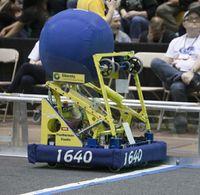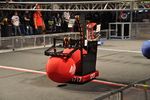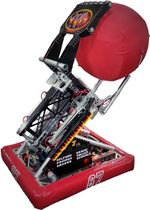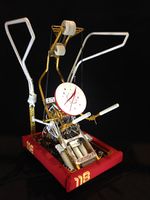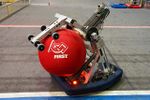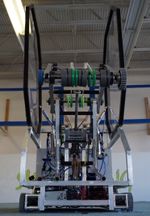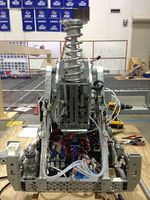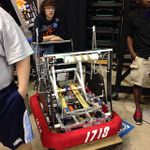2014 FRC Season
Contents
The Game
The 2014 game was called Aerial Assist and is widely considered to have been the best game in FRC history. Game Manual on FIRST's website.
Arena
The arena was a flat 25’ x 54’ foot field, straddled by a lighting truss suspended just over five feet above the floor. Above each driver station were two goals, which combined to be the full width of the field. On each corner of the field was a low goal that balls could be inserted into from the front, top, or sides. The field was split into thirds with a blue zone, red zone, and neutral zone. The game pieces were 24" diameter rubber Exercise Balls with a fabric covering. Human players stood on each side of the field, with the "intended" job of catching balls that were shot off the field.
Scoring
Autonomous
Each match started with a 10 second autonomous period. Each alliance starts with up to three balls on their side, which they attempted to score through the high or low goals. Goals scored in autonomous are worth 5 additional points each. Additionally, each high/low pair of goals was be designated “hot” for 5 seconds, in a randomized order. Points scored in the "hot" goal were worth an additional 5 points. All autonomous balls must have been scored before teleoperated scoring could begin.
Teleoperated
Once all of an alliance's autonomous balls were scored, a single ball of their color was introduced to the field. Points were scored by shooting the ball into the high or low goals. A goal was worth more as each alliance got more "assists". Assists were earned when a unique alliance robot contacted the ball in a unique zone of the field. Because there are three zones on the field and three robots, there were a maximum of three possible assists in a cycle. Additional points could be gained by "hurdling" the ball over the truss, and for catching the ball after the hurdle. Points for assists were only counted once the ball entered the goal, whereas hurdle and catch points were awarded immediately.
Table of Scoring Values
| Action | Base | AUTO (=Base+5) |
AUTO & HOT (=Base+5+5) |
1 Assist (=Base+0) |
2 Assist (=Base+10) |
3 Assist (=Base+30) |
|---|---|---|---|---|---|---|
| Low Goal | 1 | 6 | 11 | 1 | 11 | 31 |
| High Goal | 10 | 15 | 20 | 10 | 20 | 40 |
| Truss | 10 | |||||
| Catch | 10 | |||||
| Mobility | 5 |
Competition
In 2014 there were 10665 matches played across 99 events.
The highest ELO teams were:
| Rank | Team | Elo |
|---|---|---|
| 1 | 254 | 2057 |
| 2 | 1114 | 1963 |
| 3 | 67 | 1950 |
| 4 | 1718 | 1942 |
| 5 | 27 | 1940 |
| 6 | 359 | 1937 |
| 7 | 469 | 1935 |
| 8 | 148 | 1931 |
| 9 | 2056 | 1922 |
| 10 | 1678 | 1919 |
Winning Alliance
| Team 254 | Team 469 | Team 2848 | Team 74 |
|---|---|---|---|
| CD Thread Tech Binder Build Blog Reveal Video |
Season Highlights Video | CAD Link Reveal Video |
Finalist Alliance
| Team 1678 | Team 1114 | Team 1640 | Team 5136 |
|---|---|---|---|
| CD Thread Robot Information Season Recap |
CAD Link Tech Binder |
Season Recap |
Team Paradox in 2014
Team Accomplishments
Main Article: Team Paradox in 2014
Main Article: 2014 Robot (Mr. Snacky)
2102's competitive record is below:
| Event | Quals Record | Rank | Alliance Selection | Playoffs Record | Awards |
|---|---|---|---|---|---|
| San Diego Regional | 5-8-0 | 37th of 60 | 1st pick onto Alliance 6 by 3491 with 3965 | Quarterfinalist | |
| Las Vegas Regional | 8-5-0 | 9th of 50 | 7th alliance Captain with 3598 and 2486 | Quarterfinalist |
Game Strategy
The basic strategy of Aerial Assist was to assign each robot to a specific roll. An inbounder stayed in the near section of the field to receive the ball and pass it off to the next teammate, playing defense otherwise. The midfield robot then took the ball and delivered to the third robot to pick up and score.
At higher levels of play, the human players became a significant contributor to the alliance. The most important aspect of Aerial Assist gameplay was never losing control of the ball, because chasing down a stray ball wasted precious time. By having a robot hurdle the ball diagonally across the truss to the human player who then delivers the ball to an alliance robot, credit could be earned for the hurdle and assist. Robots trying to catch balls were subject to heavy defense from the opposing alliance, but the human player was not, leaving them better able to complete the assist quickly and accurately. Although it sacrificed the 10 catch points for that cycle, the speed and reliability of the human player hand-off was worth the extra points. Typically speaking, one of the robots would usually have only momentary contact with the ball. The following two cycles were common in high level play:
Cycle A
- Human player 1 introduces ball to robot 1
- Robot 1 passes back to human player 1
- Human player 1 passes the ball to robot 2
- Robot 2 hurdles ball diagonally over truss to human player 2
- Human player 2 hands ball to robot 3
- Robot 3 scores in high the (or low) goal
This cycle can be easily seen in by the 2056's (red) alliance in IRI Semifinal 2-3.
Cycle B
- Human player 1 introduces ball to robot 1
- Robot 1 hurdles ball diagonally over truss to human player 2
- Human player 2 passes ball to robot 2
- Robot 2 passes ball back to human player 2
- Human player 2 passes ball to robot 3
- Robot 3 scores in the high (or low) goal
This cycle can be seen by the 2056's (blue) alliance in IRI Finals 1.
While high goals were obviously preferred to low goals, a complete cycle with a low goal scored was worth 41 points compared to 50 points for a high goal. Getting the next cycle started was typically more important than ensuring a high goal, especially if the scoring robot was under heavy defense as a low goal could be scored more reliably.
Engineering Problems and Solutions
Intaking
By late in the season, ground intakes were only used in autonomous, or in the relatively rare circumstances where a robot lost control of a ball. Successful intakes went mostly one of two directions, both of which involved horizontal rollers. Team 148 was a notable exception, as they used two rotating cantilevered roads extending outwards for a touch-it own-it intake with a wide pickup area (similar designs were used by 1577 and 3175, among others).
Full-Width Rollers (254/1678 Style)
Likely the most common intake style, these intakes usually consisted of two arms attached to the sides of the robot with a roller spanning between their ends (typically close to the full-width of the robot). The arms were typically actuated outwards by pneumatics, but could have been motor driven as well. Seven of the eight teams on the Einstein finals field used this style intake.
Notable Examples:
| CD Thread Tech Binder Build Blog Reveal Video |
CD Thread Design Binder Reveal Video |
CD Thread Robot Video Highlight Reel |
Claw with Rollers (1114/118 Style)
For teams with a pivoting claw that served as both an intake an manipulator, intakes were usually integrated with the claw rather than being a separate mechanism. Claws tended to have two tusks supporting the ball from the bottom with a single tusk supporting the ball from the top. Most teams doing this also had the claw close slightly when intaking (to provide compression) and then open again to launch. 1114 was the only team on the Einstein finalist field to use this style intake, as their robot was inspired by their championship winning 2008 robot. 2102's robot also used an articulating claw with rollers on the upper arms.
Notable Examples:
| CAD Link Build Season Photos |
CAD Link Build Blog Reveal Video |
CAD link Controls Documentation Technical Documentation Photo Albums Season Highlights Match Video |
Catching
Many teams designed catchers into their robots from the start. As the game meta evolved, catching trussed shots became less and less valuable and by championships most high level robots had removed their catchers.
Compliant Posts
The simplest catcher design were compliant vertical posts sticking up from the robot. When a ball hit them, the posts would bend, absorbing the energy from the ball and slowing it enough to fall into the robot. An example of this can be seen in Team 900's "Secret Sauce 2.0" video.
Wings
The next step up from passive catchers were articulated wings, as seen in 118 and 33's robots. They started within the frame perimeter of the robot, and then articulated outwards to the maximum allowable dimension of 20" outside of the frame perimeter for the largest possible catch area.
Launching
Linear Punches
Linear punches typically used a motor or pneumatic cylinder to pull back a spring-loaded plunger into a latch, which then released to launch the plunger forward. These were most common in robots using the "claw" design. The launching force was generated either with springs, surgical tubing, or sometimes pneumatics (although it was difficult to get enough flow rate to make a viable pneumatic launcher). The benefit of a linear punch (or catapult) is that the launching force isn't dependent on the compression of the ball, which leads to a very consistent shot trajectory. The biggest drawback is that the "pull, latch, release" mechanism is necessarily complex. 2102's robot used a surgical tubing launcher with a pneumatic cylinder to pull the plunger back and a pneumatic latch to hold and release the shot. Notable Examples:
| Reveal Video | CD Thread about Punch CAD Link Build Blog Reveal Video |
CAD link Controls Documentation Technical Documentation Photo Album Season Highlights Match Video |
Catapults
Catapults may have been the most common type of launcher used in Aerial Assist. They were functionally similar to the linear punch designs, relying on rotational motion instead of linear motion. Similar to a linear punch, the velocity of a shot isn't dependent on the compression of the ball, leading to consistent trajectories. The biggest drawback of a catapult compared to a linear punch is that a poorly controlled release angle can introduce some variation that wouldn't otherwise exist. The largest benefit is that smooth rotational motion is much easier to achieve than smooth linear motion.
| Reveal Video Drivetrain CAD CD Thread |
Promo Video | Season Highlights Video |
Flywheel Shooters
Hot Goal Detection
During autonomous, each of the two goals spent five seconds designated as "hot," in a randomized order. Scoring in the hot goal was worth 5 additional points. The higher scoring an autonomous a team had, the more valuable hot goal detection became. The hot goals were signified two ways: light strips around the hot goal lit up, and a strip of retroreflective tape flipped around on the side of the hot goal. Early in competition it was discovered that the retroreflective tape didn't always flip immediately, and it had 0.5 - 1.5 seconds of variation, which was enough to disrupt a high level autonomous routine.
Banner Sensors
Some teams used a vision sensor made by Banner to detect the retroreflective tape on the field, but they were not entirely reliable, and the actuation time of the tape strips cost precious seconds.
Vision Tracking
Vision tracking in 2014 was usually accomplished with an Axis 206, M1011, or M1013 network camera, with a Beaglebone Black acting as a coprocessor. Vision tracking with a camera in 2014 was a significant code undertaking, but was fairly widespread.
Cheesy Vision
254 created a unique system for identifying the hot goal that wasn't affected by the timing inconsistency of the retroreflective tape. They published it publicly on April 8, 2014, between the end of regionals/districts and the beginning of DCMPs and the Championship. Cheesy Vision used the webcam of their driver station laptop to identify which hand the driver was holding up, communicating to the robot which goal to target. This was legal as the manual stated "During AUTO, TEAM members in the ALLIANCE STATION must remain behind the STARTING LINE and may not contact the OPERATOR CONSOLE" without directly prohibiting the drive team from controlling the robot.
Similar systems were created independently by other teams, including a team that used a tuning fork that was read by the laptop's microphone.








